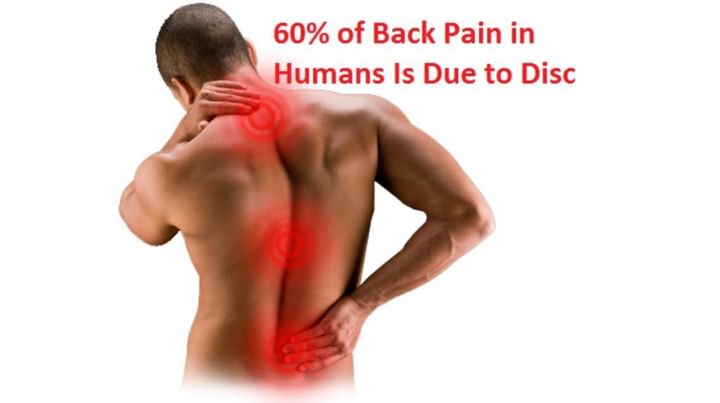60% of Back Pain in Humans Is Due to Disc
THE INTERVERTEBRAL DISC
At its simplest, the spine gets most of its movement from each cotton reel sitting on its discal pillow and careening about in all directions.The back compartment has to control the movement.The intervertebral discs are the pillows and they are vital to the spine. Their high bursting pressure thrusts the vertebrae apart while at the same time gluing them together. Each has a vigorous incompressibility, like standing on a breadboard balanced on a beach ball. They give the spine aquivering up-thrusting romp which makes it whippy a light so it can tip around freely in the air without flopping over like a broken reed.Each disc consists of a squirting liquid centre called the nucleus and a tough meshed outer wall called the annulus fibrosis. The annulus in turn is made up of approximately twelve thin fibrous layers (called lamellae) which make up the wall.
For maximum strength in bending, each successive lamella is made of fibers running in diagonally opposing directions,like the walls of a radial car tyre. This creates a tenacious multi-layered tubular lattice running around the rim of the disc which is bonded strongly to the vertebrae above and below.
Thus the disc wall not only holds the vertebrae firmly together; it also keeps the nucleus under pressure.The lamellae at the back of the disc are even thinner and bunched closely together.
This gives the inter space more freedom to pull apart so the spine can bend forward-its most frequent act-but it also means it is weaker, introducing a precarious trade-off between freedom to bend and the possibility that over-bending could break down the wall.Often the L5 discs are kidney-shaped, which exposes a longer flank and increases the holding power of the back wall.
However , kidney-shaped discs have the disadvantage of rankling more inthe acute back corners when torsion strains are applied to the disc. You will see later how heavy duty lifting and twisting actions can make the wall perish at these points.
The nucleus of the disc has a unique molecular make-up which allows it to attract fluid to keep itself hydrated under pressure. (when healthy nuclear material is taken from a disc and set in a saucer of fluid it swells by 300 percent). This powerful attractive force from the nucleus maintains the high pressures within the disc so it is not squashed dry, as a normal sponge would be, by the powerful and ever-present forces bearing down upon it.When a disc is young,the nucleus is nearly 90 percent water but as it gets older it is less able to hold it. Even so, the strong suction on water creates very high intradiscal pressures.
Apart from making the disc unsquashable, it forces the disc walls outwards, which has ingenious benefits for the spine. The strength of the walls fighting back against the outward force stiffens them and gives each link between the vertebrae invaluable tensile strength.
This dynamically braces each link and keeps the spine taut all the way down its length.In the world of physics, a disc operating like this is called an ‘hydraulic sack’. Compression of a contained fluid results in forces being distributed outwards and evenly in all directions through that fluid. In the realm of backs, this is very important and the fluid content of any disc is very critical to its high performance.
Our vertical posture enhances the tensile strength of the spine. It adds to the pressurizing of the fluid sucks and converts the spine into a spring –loaded rod which can flip up straight again after bending.
Without these tensile properties, the human back would not be the long slender thing it is. We would need a hugely bulky muscular apparatus to haul us up straight again once we had doubled over.But vertical posture does have its down side. It means the segments at the bottom of the stack get squashed by carrying so much weight. Compression down through the spine is the single most important cause of low back pain.



+1.svg)
